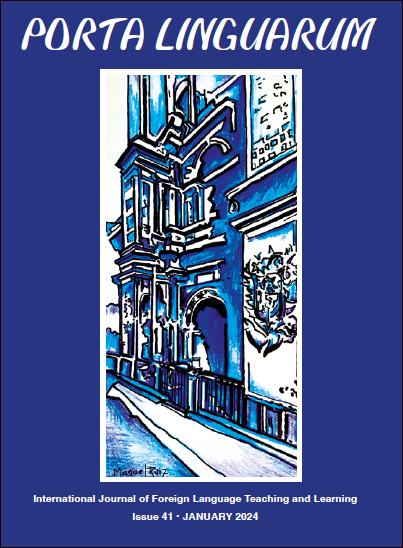Development of written language in Spanish as a foreign language in the context of autonomous study
DOI:
https://doi.org/10.30827/portalin.vi41.26608Keywords:
dynamic systems theory, complexity, accuracy and fluency, written production, autonomous study, dynamic developmentAbstract
The work carries out a longitudinal study of a class of Chinese undergraduate students majored in Spanish. Based on the theory of dynamic systems (DST) and data visualization methods, we study the group and individual development of the complexity, accuracy and fluency (CAF) of the writings made in the autonomous study mode. The result shows that: (1) the characteristic of a fluctuating and non-linear development does not depend on the study environment; (2) the change of the environment exerts positive influences on syntactic complexity and fluency, and negative influences on lexical complexity and precision; (3) the students of similar level present different patterns of linguistic development. The student with positive learning beliefs and awareness of improving CAF tends to experience less dip and fluctuation in the self-study environment. The results are explained by the DST and the retrospective interviews. The work paves the way for analysis of the acquisition of Spanish as a foreign language on vacation.
Downloads
References
Ai, H. & Lu, X. (2013). A corpus-based comparison of syntactic complexity in NNS and NS university students’writing. En A. Díaz-Negrillo, N. Ballier & P. Thompson (Eds.), Automatic Treatment and Analysis of Learner Corpus Data (pp. 249-264). John Benjamins.
Baba, K. & Nitta, R. (2014). Phase transitions in development of writing fluency from a complex dynamic systems perspective. Language Learning, 64(1), 1-35.
Bulté, B. & Housen, A. (2014). Conceptualizing and measuring short-term changes in L2 writing complexity. Journal of Second Language Writing, 26, 42-65.
Chan, H. P., Verspoor, M. & Vahtrick, L. (2015). Dynamic development in speaking versus writing in identical twins. Language learning, 65(2), 298-325.
Chang, Ch & Chang, H. Ch. [常畅, 常海潮]. (2020).国内二语写作研究回顾与前景展望. 外语电化教学, 42(3), 61-67,10.
Chen, Y. D. [陈意德]. (2017). 动态系统理论视角下大学生英语程式语习得因素研究. 外国语文, 33(6), 81-86.
Dai, Y. C. & Wang, T. Sh. [戴运财,王同顺]. (2012).基于动态系统理论的二语习得模式研究. 山东外语教学, 21(5), 36-42.
De Bot, K. (2008). Second Language Development as a Dynamic Process. The Modern Language Journal, 92, 166-178.
de Bot, K. & Larsen-Freeman, D. (2011). Researching second language development from a dynamic systems theory perspective. En M. Verspoor, K. de Bot & W. Lowie (Eds.), A dynamic approach to second language development: methods and techniques (pp. 5-25). John Benjamins.
de Bot, K., Lowie, W. & Verspoor, M. (2007). A dynamic systems theory approach to second language acquisition. Bilingualism: Language and Cognition, 10(1), 7 -21.
Huang, T. & Zheng, Y.Y. [黄婷,郑咏滟]. (2022).双外语学习是否阻碍第一外语发展?——来自句法复杂度的证据. 现代外语, 45(5), 697-709.
Fogal, G. G. (2020). Investigating variability in L2 development: Extending a complexity theory perspective on L2 writing studies and authorial voice. Applied Linguistics, 41(4), 575-600.
Larsen-Freeman, D. (2006). The emergence of complexity, fluency, and accuracy in the oral and written production of five Chinese learners of English. Applied Linguistics, 27(4), 590-619.
Larsen-Freeman, D. (1997). Chaos /Complexity Science and Second Language Acquisition. Applied Linguistics, 91(3), 141-165.
Larsen-Freeman, D. & Cameron, L. (2008). Complex Systems and Applied Linguistics. Oxford: Oxford University Press.
Li, J. & Cai, Y. Zh. (2022). El desarrollo dinámico de la expresión escrita de alumnos chinos que estudian la lengua española. Rasal Lingüística, 19(2), 29-60.
Li, L. X. [李兰霞]. (2017). 动态系统理论与第二语言发展: 从个案研究开始. 北京: 中国社会科学出版社.
Lowie, W. (2017). Lost in state space? Methodological considerations in Complex Dynamic Theory approaches to second language development research. In L. Ortega & Z. Han (Eds.), Complexity Theory and Language Development: In Celebration of Diane Larsen-Freeman (pp. 123-142). John Benjamins.
Lowie, W., Dijk, M. V., Chan, H. & Verspoor, M. (2017). Finding the key to successful L2 learning in groups and individuals. Studies in Second Language Learning & Teaching, 7(1), 127-148.
Lowie, W. & Verspoor, M. (2015). Variability and variation in second language acquisition orders: A dynamic reevaluation. Language learning, 65(1), 63-88.
Mazgutova, D. & Kormos, J. (2015). Syntactic and lexical development in an intensive English for Academic Purpose programme. Journal of Second Language Writing, 29(9), 3-15.
Saadat, M. & Alavi, S. Z. (2017). Inter-individual variability in CAF: A case study of two individuals and two pairs’ written productions. International Journal of English Language & Translation Studies, 5(2), 61-74.
Spoelman, M. & Verspoor, M. (2010). Dynamic patterns in development of accuracy and complexity: A longitudinal case study in the acquisition of Finnish. Applied Linguistics, 31(4), 532-553.
Ushioda, E. (2015). Context and dynamic systems theory. En Z. Dornyei, P. D. MacIntyre & A. Henry (Eds.), Motivational Dynamics in Language Learning (pp. 47-54). Bristol: Multilingual Matter.
van Geert, P. (1995). Growth dynamics in development. En R. Port & T. van Gelder (Eds.), Mind as motion: Explorations in the dynamics of cognition (pp. 313-337). Bradford Book.
van Dijk, M., Verspoor, M. & Lowie, W. (2011). Variability and DST. En M. Verspoor, K. de Bot & W. Lowie (Eds.), A Dynamic Approach to Second Language Development: Methods and Techniques (pp. 55-84). John Benjamins.
Verspoor, M. (2015). Initial conditions. En Z. Dörnyei, P. D. Maclntyre & A. Henry (Eds.), Motivational Dynamics in Language Learning (pp. 38-46). Multilingual Matters.
Verspoor, M. & Smiskova, H. (2012). Foreign language writing development from a dynamic usage-based perspective. En R. Manchon (Ed.), L2 Writing Development: Multiple Perspectives (pp. 1-34). Walter de Gruyter.
Wang, H. H., Li, B. B. & Xu, L. [王海华, 李贝贝, 许琳]. 2015. 中国英语学习者书面语水平发展个案动态研究. 外语教学与研究, 59(1), 67-80.
Yu, H. J. [于涵静]. (2020).中国学习者英语口语流利性动态发展研究———兼论复杂性、准确性和流利性的互动关系. 外语界, 41(2), 81-89.
Zheng, Y. Y. [郑咏滟]. (2015). 基于动态系统理论的自由产出词汇历时发展研究. 外语教学与研究, 36(2), 276-288.
Zhu, H. M. [朱慧敏]. (2021). 二语书面语句法发展及其动态增长模型建构研究. 外语与外语教学, 38(2), 103-114.
Zhu, H. M. & Liu, Y. M. [朱慧敏,刘艳梅]. (2021). 二语写作词汇复杂度动态发展个案研究.山东外语教学, 42(5), 54-64.
FUNDING INFORMATION
El trabajo ha sido patrocinado por el Proyecto de Reforma de la Enseñanza de Educación Especial Ideológica y Política para los estudios de grado de la Universidad Renmin de China. El número de proyecto es KCSZ202214.



















